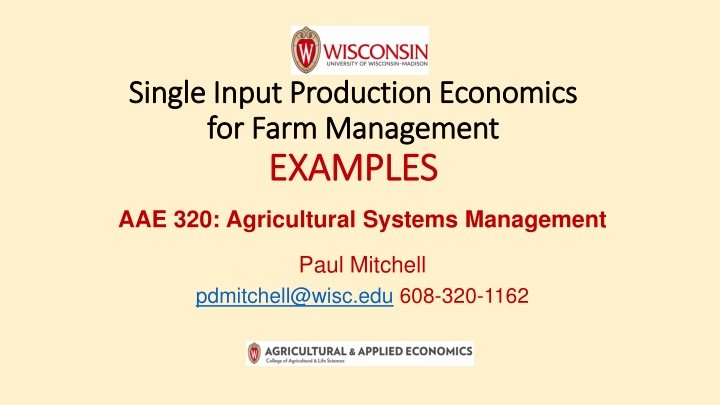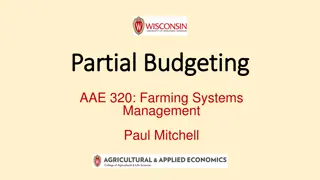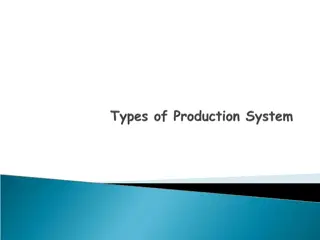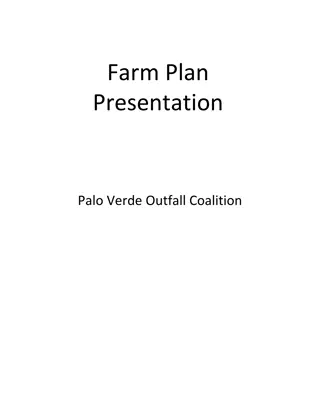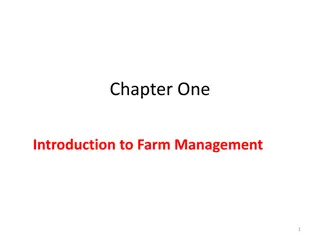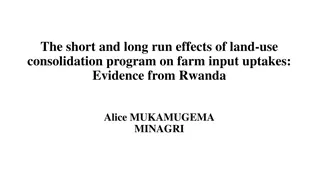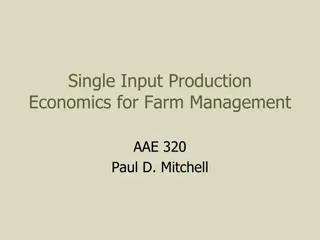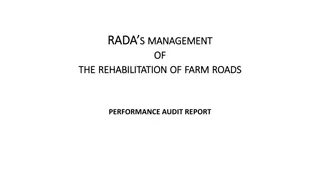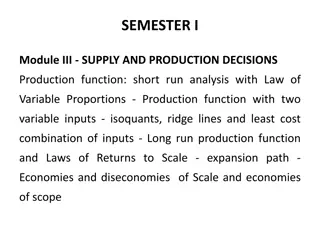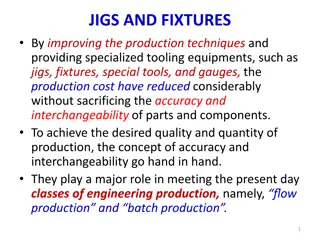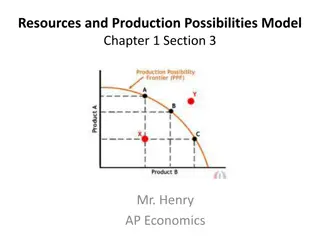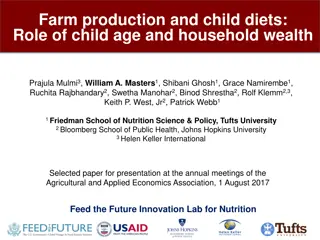Single Input Production Economics in Farm Management
This content explores examples and explanations of single input production economics for farm management, illustrating concepts such as linear interpolation and optimization in agricultural systems. It covers topics like determining the optimal fertilizer rate, maximizing profits, and analyzing worker productivity in vegetable farming scenarios.
Download Presentation

Please find below an Image/Link to download the presentation.
The content on the website is provided AS IS for your information and personal use only. It may not be sold, licensed, or shared on other websites without obtaining consent from the author.If you encounter any issues during the download, it is possible that the publisher has removed the file from their server.
You are allowed to download the files provided on this website for personal or commercial use, subject to the condition that they are used lawfully. All files are the property of their respective owners.
The content on the website is provided AS IS for your information and personal use only. It may not be sold, licensed, or shared on other websites without obtaining consent from the author.
E N D
Presentation Transcript
Single Input Production Economics Single Input Production Economics for Farm Management for Farm Management EXAMPLES EXAMPLES AAE 320: Agricultural Systems Management Paul Mitchell pdmitchell@wisc.edu 608-320-1162
Example #1 N Yield bu/A 50 90 120 148 172 192 210 222 228 230 lbs/A 0 20 40 60 80 100 120 140 160 180 AP --- MP --- 2 VMP --- $7 Fill in the columns in the table using $3.50/bu for the corn price What is the profit maximizing N fertilizer rate if the N fertilizer price is $0.35/lb?
Example #1 Answer N Yield bu/A lbs/A AP --- MP --- VMP --- 0 20 40 60 80 100 120 140 160 180 50 90 120 148 172 192 210 222 228 230 90/20=4.50 120/40=3.00 148/60=2.47 172/80=2.15 1.92 1.75 1.59 1.43 1.28 (90-50)/(20-0)=2 (120-90)/(40-20)=1.5 (148-120)/(60-40)=1.4 (172-148)/(80-60)=1.2 1 0.9 0.6 (228-222)/(160-140)=0.3 (230-228)/(180-160)=0.1 2x3.50=7.00 1.5x3.50=5.25 1.4x3.50=4.90 1.2x3.50=4.20 3.50 3.15 2.10 1.05 0.35
Linear Interpolation You have a variable A with two values A0 and A1 and matched with it is another variable B with two values B0 and B1 You know Abtwn that is between A0 and A1 and you want to linearly interpolate what the corresponding Bbtwn is How do you find Bbtwn when you know A0, A1, B0, B1 and Abtwn? B1 Bbtwn B0 A0 Abtwn A1
Linear Interpolation B1 Bbtwn B0 This formula will hold ????? ?0 ????? ?0 =?1 ?0 ?1 ?0 A0 Abtwn A1 Works either way B1 Solve this for Bbtwn ?????= ??+ (????? ??)?? ?? Bbtwn B0 ?? ?? A1 Abtwn A0
Linear Interpolation Example Suppose have inputs & VMPs from this table & input price is $0.60 What is the optimal N? Where VMP = 0.6, so linearly interpolating between 1.05 & 0.35 Can ignore these cols ????? Known ????? Unknown Input N (B) 160 180 VMP (A) 1.05 0.35 Yield MP 228 230 Row 0 0.3 0.1 What N? 0.6 Row 1 ?????= ?0+ (????? ?0)?1 ?0 ?0=1.05 ?1=0.35 ?????=0.60 ?0=160 ?1=180 ?????=??? ?1 ?0 180 160 0.35 1.05 20 0.7= 172.9 ?????= 160 + (0.6 1.05) ?????= 160 + ( 0.45) 172.9
Example #2 You manage a small vegetable farm, the table reports how many bags of potatoes are dug, cleaned, and ready for sale in one hour with different numbers of workers How many workers is it optimal to hire if potatoes sell for $2/bag and you hire workers for $20/hr? What if the wage is $18/hr? Workers Bags/hr 3 5 7 9 MP VMP 50 75 95 105
Example #2 Answer How many workers is it optimal to hire if potatoes sell for $2/bag and you hire workers for $20/hr? What if the wage is $18/hr? MP = (75-50)/(5-3) = 12.5 VMP = 2 x MP = $25 Optimal where VMP = r occurs at 7 workers where VMP = $20 Workers Bags/hr 3 5 7 9 MP -- 12.5 10 5 VMP -- 25 20 10 Interpolation for wage = $18/hr ?????= ?0+ (????? ?0) ?1 ?0 ?1 ?0 7 9 20 10 50 75 95 105 ?????= 7 + (18 20) ?????= ?.?
Example #3 Soybean yield is Q = 3 + 2S 0.01S2, where yield Q is total bushels per acre (bu/ac) and the seeding rate S is thousands of seeds planted per acre. The soybean price is $9/bu and seeds cost $0.35 per thousand seeds. What is the economically optimal seeding rate (S) to plant? Set up and solve this economic problem using calculus. Check the second order condition. At the seeding rate S you find, what is the soybean yield (bu/ac)? Besides seed costs, other costs = $800/ac. What are net returns ($/ac)?
Example #3: Answer Set Up: = 9(3 + 2S 0.01S2) 0.35S FOC: d /dS = 9(2 0.02S) 0.35 = 0 Solve FOC: 9(2 0.02S) = 0.35 2 0.02S = 0.35/9 = 0.039 2 0.039 = 0.02S S = 1.961 / 0.02 = 98.05 (or 98 thousand seeds/ac) SOC: d2 /dS2 = 9( 0.02) = 1.8 < 0 passes SOC for maximum Yield: Q = 3 + 2S 0.01S2 = 3 + 2(98) 0.01(98) 2 = 102.96 = 103 bu/ac Profit: = 9(103) 0.35(98) 800 = $92.70/ac Profit: = 9(102.96) 0.35(98.05) 800 = $92.32/ac
Example #4 Corn yield is Y = 150 +0.994N 0.00228N2, where Y is corn yield in bushels per acre and N is the total nitrogen applied as pounds of N per acre. The corn price is $5/bu. Urea N nitrogen fertilizer solution (which is 45% N by weight) costs $400/ton. What nitrogen application rate maximizes net returns? Set up and solve this economic problem using calculus. Check the second order condition. At the nitrogen rate N you find, what is the corn yield (bu/ac)? Besides nitrogen costs, other costs = $900/ac. What are net returns ($/ac)?
Price Conversions Many ag inputs often require price conversions. For example, fertilizer is priced in dollars per ton and often needs to be converted to dollars per pound of the active ingredient (Nitrogen) You buy Urea (CH4N2O), which is 45% N, for $400 per ton, what is the cost of the Nitrogen in $ per pound? ??? ?? ???? x 1 ??? ?? ???? Why 45%? Atomic masses C=12, N=14, H=1, O=16: 2 N s divided by the mass of the molecule: 28/(12+4+28+16) = 28/60 = 46.7%, then 45% due to other stuff $400 1 ??? ?? ? 2,000 ??? ?? ?=$0.44/lb of N 0.45 ??? ?? ? x
Example #4: Answer Set Up: = 5(150 +0.994N 0.00228N2) 0.44N ??? ?? ???? x 1 ??? ?? ???? $400 1 ??? ?? ? 2,000 ??? ?? ? =$0.44/lb of N Price conversion 0.45 ??? ?? ? x FOC: d /dN = 5(0.994 0.00456N) 0.44 = 0 Solve FOC: 5(0.994 0.00456N) = 0.44 0.994 0.00456N = 0.44/5 = 0.088 0.994 0.088 = 0.00456N N = 0.906 / 0.00456 = 198.7 lbs/ac SOC: d2 /dN2 = 5( 0. 0.00456) = 0.0228 < 0 passes SOC for maximum Yield: Y = 150 + 0.994(199) 0.00228(199)2 = 257.5 bu/ac Profit: = 5(257.5) 0.44(199) 900 = $299.94/ac = $300/ac
